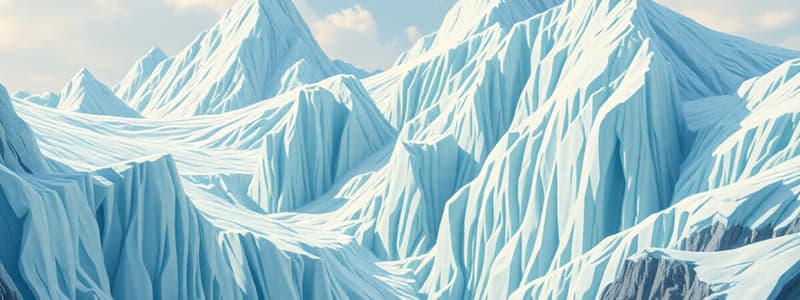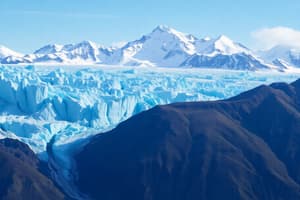Podcast
Questions and Answers
What primarily causes the movement of ice within a glacier?
What primarily causes the movement of ice within a glacier?
What transforms snow into glacier ice during the glacier formation process?
What transforms snow into glacier ice during the glacier formation process?
Which of the following best describes the zone of ablation in a glacier?
Which of the following best describes the zone of ablation in a glacier?
Which of the following statements accurately describes alpine glaciers?
Which of the following statements accurately describes alpine glaciers?
Signup and view all the answers
What is the primary factor influencing the overall glacial budget?
What is the primary factor influencing the overall glacial budget?
Signup and view all the answers
What is the primary distinction between glaciers and icebergs?
What is the primary distinction between glaciers and icebergs?
Signup and view all the answers
Which characteristic distinguishes the plastic zone within a glacier?
Which characteristic distinguishes the plastic zone within a glacier?
Signup and view all the answers
What role do the air pockets trapped within solid glacial ice serve?
What role do the air pockets trapped within solid glacial ice serve?
Signup and view all the answers
What is calving in relation to glaciers?
What is calving in relation to glaciers?
Signup and view all the answers
Which statement accurately reflects the conditions necessary for glacier formation?
Which statement accurately reflects the conditions necessary for glacier formation?
Signup and view all the answers
Study Notes
Earth's Cryosphere
- Earth's cryosphere (ice) has unique erosional and depositional features compared to the hydrosphere (liquid water).
- Ice exists primarily as glaciers and icebergs.
- Glaciers are year-round land-based ice accumulations.
- Icebergs are floating ice masses, often originating from glaciers.
Glacier Formation
- Glaciers form from accumulated snow not fully melted annually.
- Perennial snow lasts all year.
- Snow fields are thin perennial snow accumulations.
- Snow compacts, bonds with underlying layers, and reduces void space.
- Buried snow layers compact into firn (névé), a granular ice mass.
- Continued burial, compression, and recrystallization form glacier ice, which retains trapped air pockets (atmospheric records).
- Three glacier types:
- Alpine/Valley glaciers: Found in major mountain ranges (e.g., Andes, Rockies, Alps, Himalayas) and some lower elevation areas with high precipitation.
- Ice sheets (continental glaciers): Cover large land areas (e.g., Greenland, Antarctica); Greenland Ice Sheet is the largest Northern Hemisphere ice mass, with over 2 million sq km (1,242,700 sq mi) and up to 1500 meters thick. Antarctic Ice Sheet is even larger, covering almost the entire continent, exceeding 4,000 meters thick in some places.
- Ice caps: Smaller than ice sheets, typically cover less than 50,000 km2, often found at high elevations (e.g., Iceland).
Glacier Movement
- Accumulated ice flows downslope under its own weight.
- Glaciers move relatively slowly at the bottom, faster in the middle, and the top ice is carried along below.
- Ice melts under pressure.
- About half of the glacial movement is from sliding on a meltwater film, the other half from internal flow.
- A brittle zone (top 50m roughly) may produce crevasses (large cracks).
- Below the brittle zone, ice is more plastic. The plastic zone has sediment.
- Sediment acts as grinding agents causing substantial bedrock erosion.
Glacial Budget
- A glacial budget is similar to a bank account. Glacier growth occurs when snow accumulation exceeds melt.
- Zone of accumulation where snow accumulation exceeds melting.
- Zone of ablation where snow and ice melt.
- Equilibrium line or firnline: boundary between the zones.
- Summer melt matters more to glacial budgets than winter accumulation; cooler summers promote advances, while warmer summers promote retreats.
Glacial Landforms
- Glaciers create erosional and depositional landforms.
- Erosional features are formed by glacial ice removal.
- Depositional features by glacial ice deposits.
Erosional Glacial Landforms
- Glaciers erode bedrock through plucking and abrasion into rock flour.
- Resultant features include:
- U-shaped valleys (from former V-shaped stream valleys).
- Arêtes (sharpened ridges between valleys).
- Cirques (bowl-shaped features at glacier heads).
- Tarns (cirque lakes).
- Horns (steep-sided, spire-shaped mountains).
- Cols (mountain passes).
- Hanging valleys (tributary valleys left higher than the main valley).
- Truncated spurs (steep triangle-shaped cliffs from eroded ridge ends).
Depositional Glacial Landforms
- Depositional features are called drift.
- Includes poorly-sorted till (clay, silt, pebbles, boulders).
- Tillites and diamictites are lithified till.
- Moraines (mounded till deposits):
- Terminal moraines (at glacier terminus).
- Recessional moraines (as glacier retreats).
- Lateral moraines (along glacier sides).
- Medial moraines (where lateral moraines merge).
- Ground moraine (till left on the land).
- Outwash plains (sediment deposited by meltwater).
- Glacial erratics (large, misplaced boulders).
- Kettles and kettle lakes (depressions and lakes from melted ice blocks).
- Eskers (sinuous ridges of sediment in meltwater channels).
- Kames (mounds of till deposited by meltwater).
- Drumlins (elongated hills reflecting ice movement).
- Tarns (cirque lakes).
- Paternoster lakes (series of lakes in a valley).
- Finger lakes (long, glacially carved depressions filled with water).
- Proglacial lakes (lakes at the glacier edge). Proglacial lakes include Lake Agassiz, Lake Winnipeg and Lake Missoula, formed when glaciers dammed river valleys, with substantial catastrophic drainage in some cases.
- Pluvial lakes (lakes formed in humid, cold environments): Examples include Lake Bonneville and Lake Lahontan.
Ice Age Glaciations
- Glaciations happen when Earth's climate becomes cold enough for continental ice sheet expansion.
- Four major recorded glaciations.
- Most recent glaciation: series of glacial cycles, ~18 during the Pliocene-Pleistocene Epoch (2.5 million years ago).
Causes of Glaciations
- Long-term causes (tens to hundreds of millions of years): plate tectonics, shifting landmasses, ocean circulation changes.
- Short-term causes (hundreds to thousands of years): Milankovitch Cycles (variations in Earth's rotation and orbit). This affects incoming solar radiation leading to short-term climate changes.
Sea-Level Change and Isostatic Rebound
- Glacial melting causes global sea-level rise and isostatic rebound (land rising as ice melts).
- Eustatic sea-level change is global sea-level change.
- Relative sea-level change includes vertical land movement.
- Isostatic rebound is the upward movement of crust after ice melts; this is relatively strong in areas where continental ice sheets rapidly melted (e.g., Canada and Scandinavia), leaving visible effects on coastlines and river terraces.
Studying That Suits You
Use AI to generate personalized quizzes and flashcards to suit your learning preferences.
Description
Explore the fascinating features of Earth's cryosphere and learn about the intricate processes involved in glacier formation. This quiz covers the differences between glaciers and icebergs, as well as the various types of glaciers found around the world. Test your knowledge of how ice accumulates and transforms over time in different environments.




